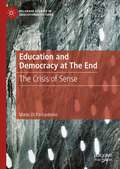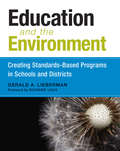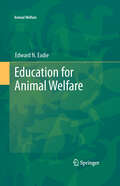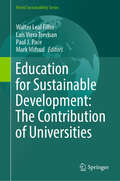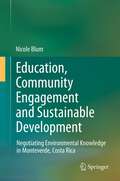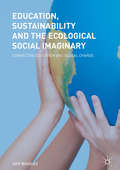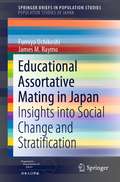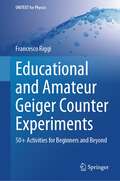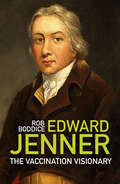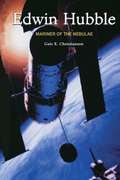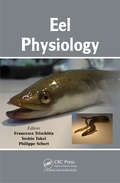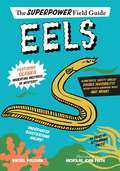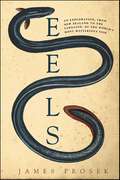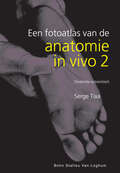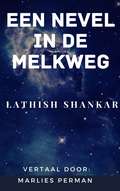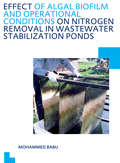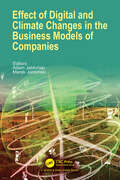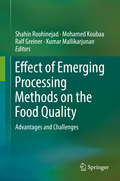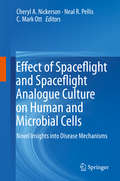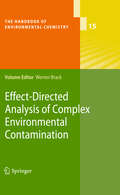- Table View
- List View
Education and Democracy at The End: The Crisis of Sense (Palgrave Studies in Educational Futures)
by Mario Di PaolantonioThis book grapples with what it means when education and democracy are at an end: when these two foundational aspects of our society seem to have reached a culminating point, no longer appearing to produce and make sense amid the crises of our time. Engaging topical political events and mobilizing a variety of cultural resources, Di Paolantonio shows that today the possibility of the future and the significance of an expansive transgenerational sensibility are radically in question as trends toward destruction, cruelty, and banality are steering world-defying calamities, and sparking “chronopathologies” of doom and despair among the planet’s occupants. Unfolding his argument through a series of accessible chapters that draw on contemporary philosophy, educational thinking, and cultural-artistic works, Di Paolantonio explores how the transgenerational sensibility retains a possibility we might tap for overcoming the impasses of our time.
Education and the Environment: Creating Standards-Based Programs in Schools and Districts
by Gerald A. LiebermanIn this timely book, curriculum expert Gerald A. Lieberman provides an innovative guide to creating and implementing a new type of environmental education that combines standards-based lessons on English language arts, math, history, and science with community investigations and service learning projects. By connecting academic content with local investigations, environmental study becomes not simply another thing added to the classroom schedule but an engaging, thought-provoking context for learning multiple subjects. The projects outlined in the book further students&’ understanding of the way human and natural &“systems&” interact locally and globally, and provide the next generation with the knowledge necessary for making decisions that will be critical to their future—and ours.
Education for Animal Welfare
by Edward N. EadieThis book deals with the role of education in improving animal welfare and reducing animal suffering inflicted by humans. It embraces situations in which humans have direct control over animals or interfere directly with them, but it considers also indirect animal suffering resulting from human activities. Education is regarded in the broad sense of creating awareness and facilitating change. First, consideration is given to a number of specific themes in which education can make an important contribution towards reducing animal suffering, and subsequently an examination is made of a number of interrelated contexts in which education can address the various themes. The considered educational themes are: · animal suffering and sentience that have both scientific and moral aspects · human discrimination against animals known as speciesism and the need for attitudinal change by humans · role and existing limitations of legislation in providing protection to animals · matter of enforcement of animal protection legislation · achievement of reform to improve animal protection by legislative and other means · training of professionals, carers, and users involved with animals to provide better protection · the scope for science to contribute to improved animal protection · animal protection as a regional and international issue
Education for Sustainable Development: The Contribution of Universities (World Sustainability Series)
by Walter Leal Filho Mark Mifsud Laís Viera Trevisan Paul J. PaceAs we confront the daunting challenges of the 21st century—climate change, social inequality, resource depletion, and the loss of biodiversity—the role of education has emerged as a pivotal force in driving transformative change. "Education for Sustainable Development: The Contribution of Universities" is a response to this urgent call for a reimagined educational landscape, one that empowers current and future generations to navigate and address the complexities of sustainability. This book seeks to outline universities' critical role as catalysts for sustainable development. As centres of knowledge creation, innovation, and community engagement, universities possess the unique ability to influence not only individual lives but also societal norms and practices. They are uniquely positioned to integrate sustainability into their curricula, research agendas, and outreach efforts, thus fostering a culture of sustainability that permeates all aspects of academic life. The need for Education for Sustainable Development (ESD) has never been clearer. By emphasising sustainability in higher education, we can raise awareness among students and faculty, inspiring them to become informed and engaged global citizens. This book serves as a comprehensive resource, offering insights, best practices, and real-world examples of how universities around the globe are advancing the principles of ESD. Within this book, the readers will find a rich tapestry of ideas and strategies designed to encourage institutions to embrace sustainability in a holistic manner. From innovative teaching methods to collaborative community partnerships, this collection reflects the diversity of approaches being implemented in universities today. It is our hope that the experiences shared will serve as a source of inspiration for educators, administrators, and policymakers. Ultimately, this book stands as a testament to the belief that education is a powerful tool for creating a more sustainable and equitable world. By fostering a deep understanding of sustainability and its interconnected dimensions, we can equip students with the knowledge and skills necessary to tackle the pressing issues we face. Together, through a collective commitment to Education for Sustainable Development, we can cultivate a better future for generations to come.
Education in the 21st Century: STEM, Creativity and Critical Thinking
by Amanda Berry Alister Jones Cathy Buntting Deborah Corrigan Richard GunstoneThis book explores a range of issues central to STEM and 21st Century education. It explores research into the relationships between creativity, critical thinking and STEM Education from both a theoretical and practical perspective. It examines matters associated with three main concerns: First is the ways some research and development that is labelled “STEM” appears to be essentially one of the specific individual components, S, T, E or M, with a new label rather than something going across and/or beyond these more traditional components. The second, at times intertwining, concern is the common ways in which school curriculum continues to hold separate disciplines as its core. The third concern is that while cross-curriculum goals are increasingly common in this century - particularly for “creativity” and “critical thinking” - it is also common that the goals remain only vaguely linked with the more usual components of the whole curriculum. This book reflects on all three of these important concerns and the integrated whole that can result from them. Monash University, King’s College London and Waikato University have now generated six edited books on successive related research issues of significance to contemporary science education. Each of these books has been substantially shaped by a writing workshop involving all authors in intensive discussion about drafts of their contributions (a process of great worth in its own right, as well as for enhancing the value of the final volume), and then each author reworking the contribution in the light of the discussions The seventh will extend beyond science education and explore a range of issues central to STEM and 21st Century education.
Education, Community Engagement and Sustainable Development
by Nicole BlumA growing body of research has given critical attention to diverse theories and practices of environmental education, and its potential contribution to addressing pressing global issues such as sustainable development and climate change. While much of this work has focused on perspectives and practices in Europe and North America, this book explores environmental learning within formal education, in programmes by non-governmental organisations, and in public education spaces in Monteverde, Costa Rica. The discussion also highlights the need for more research to understand the broader social and economic interactions between such efforts and the communities in which they are located.
Education, Sustainability and the Ecological Social Imaginary: Connective Education And Global Change
by Jeff BucklesThis book analyses the evidence for global change, and suggests that the Earth is going through a profound transformation, caused in large part by human action. Land, oceans, polar regions and the atmosphere are all being deeply affected by the human population's lifestyle: what should the educational response be to these various aspects of global change? To answer this, the values of an ecological response are developed, leading to the notion of an 'Ecological Social Imaginary', which looks at how humans can change their way of living to one that is more in harmony with the planet that they live on and depend upon. To enable this, an ecological form of education, Connective Education, is proposed. This focuses on how the human and natural world can be connected for the benefit of humankind and all living and non-living entities, joining head, hand, heart and spirit to the web of life. It is argued that through Connective Education, a particular type of person is formed: one who is able to take their place in the human and natural world, and in this way truly connect with their planet. The book will be essential reading for those working in the fields of Education and Environmental Studies.
Educational Assortative Mating in Japan: Insights into Social Change and Stratification (SpringerBriefs in Population Studies)
by James M. Raymo Fumiya UchikoshiThis book represents a first attempt to comprehensively discuss and investigate causes and potential implications of changing patterns of spouse pairing in Japan and to consider similarities and differences with patterns observed in the USA and other low-fertility Western societies. In this book, research on educational assortative mating in Japan is summarized and updated. This book contributes to research on the demography of contemporary Japan by overviewing theoretical and empirical linkages between marriage behavior and processes of social and economic stratification. It also extends the large body of research on assortative mating and stratification by incorporating insights from the understudied context of Japan. The authors draw upon multiple data sources – both survey and administrative data – to update and extend previous research on “who marries whom” in Japan. The wide range of consequences considered includes income inequality, the intergenerational transmission of advantage and disadvantage, marriage and fertility timing, lifelong singlehood, childlessness, and the family roles of husbands and wives. Throughout the manuscript, Japan is considered in comparative perspective by employing the large USA and international literatures on assortative mating.
Educational Response, Inclusion and Empowerment for SDGs in Emerging Economies: How do education systems contribute to raising global citizens? (Sustainable Development Goals Series)
by Mustafa ÖztürkThis volume analyzes cases from emerging economies in relation to the global endeavor to promote the vision of sustainable development in all forms of education. It aims to discuss the significance of hearing local voices and understanding local discourse regarding strategies for action for change, and the role of educational systems as a means to communicate, promote and educate for the Sustainable Development Goals (SDGs). In this book, emerging economies are defined as newly industrialized countries that have not yet reached developed status, but have, in a macro-economic sense, outpaced their developing counterparts. In this context, the book highlights how education in emerging economies could extend conventional economic methods to sustainability issues, or depart from money-based calculations and business-dominated values to promotion of real-life considerations and ethical, environmental and humanistic values. With the help of this volume, readers will have a chance to look at educational response, inclusion and empowerment for SDGs in countries with emerging economies, and to grasp the synthesis of Education for Sustainable Development/Global Citizenship Education (ESD/GCE) within the overall national educational systems. This volume focuses on early childhood through upper secondary education.
Educational and Amateur Geiger Counter Experiments: 50+ Activities for Beginners and Beyond (UNITEXT for Physics)
by Francesco RiggiThis book offers a comprehensive collection of introductory experiments in nuclear and cosmic ray physics utilizing Geiger counters. It features over 50 experiments with brief explanations of the physics involved, guidance on setting up educational and amateur experiments, and showcases actual results. The experiments cover the fundamentals of Geiger counters for detecting alpha, beta, gamma, and cosmic radiation, assessing detector performance, monitoring radiation in various environments and sources, conducting coincidence experiments, and applying counting statistics and analysis algorithms. Additionally, introductory chapters delve into radiation principles, interactions with matter, and the history of particle detectors, particularly Geiger counters. With the widespread availability of modern, affordable Geiger detectors and DIY devices, many experiments are suitable for high school and university students, aligning with modern physics curricula. The author has conducted some of these experiments himself over the past 20 years with third-year physics students. The book is also addressed to amateur scientists and a broad audience interested in exploring radiation phenomena. It features around 250 original illustrations and references to historical experiments and contemporary findings.
Edward Jenner: The Vaccination Visionary (Pocket GIANTS)
by Rob BoddiceEdward Jenner is a giant of modern medicine. Throughout history, smallpox had plagued humanity with disfigurement, blindness and death. It was an incurable blight, the suffering of which Jenner helped to end.Surmising from the immunity of milkmaids that cowpox might be some defence against the ravages of smallpox, in 1793 he took some of the matter from a human case of cowpox and inserted it into the arm of a young boy. To test this, the first human-to-human vaccination, he subsequently inoculated the boy with smallpox itself, and found him to be immune from the disease. In 1979 smallpox was declared extinct.In this concise biography, Rob Boddice tells the story of Jenner’s life, his medical vision and his profound legacy. It is a story that encompasses revolutions in medical experimentation, public health provision and the prevention of other diseases, from anthrax to measles, but above all it highlights the profound impact that Jenner’s vision has had upon humanity’s battle against disease.
Edwin Hubble (Groundbreakers Series)
by Fiona MacDonaldStory time just got better with Prime Book Box, a subscription that delivers hand-picked children’s books every 1, 2, or 3 months.
Edwin Hubble: Mariner of the Nebulae
by G.E ChrisitansonEdwin Hubble: Mariner of the Nebulae is both the biography of an extraordinary human being and the story of the greatest quest in the history of astronomy since the Copernican revolution. The book is a revealing portrait of scientific genius, an incisive engaging history of ideas, and a shimmering evocation of what we see when gazing at the stars.Born in 1889 and reared in the village of Marshfield, Missouri, Edwin Powell Hubble-star athlete, Rhodes Scholar, military officer, and astronomer- became one of the towering figures in twentieth-century science. Hubble worked with the great 100-inch Hooker telescope at California's Mount Wilson Observatory and made a series of discoveries that revolutionized humanity's vision of the cosmos. In 1923 he was able to confirm the existence of other nebulae (now known to be galaxies) beyond our own Milky Way. By the end of the decade, Hubble had proven that the universe is expanding, thus laying the very cornerstone of the big bang theory of creation. It was Hubble who developed the elegant scheme by which the galaxies are classified as ellipticals and spirals, and it was Hubble who first provided reliable evidence that the universe is homogeneous, the same in all directions as far as the telescope can see.An incurable Anglophile with a penchant for tweed jackets and English briars, Hubble, together with his brilliant and witty wife, Grace Burke, became a fixture in Hollywood society in the 1930s and 40s. They counted among their friends Charlie Chaplin, the Marx brothers, Anita Loos, Aldous and Maria Huxley, Walt Disney, Helen Hayes, and William Randolph Hearst. Albert Einstein, a frequent visitor to Southern California, called Hubble's work "beautiful" and modified his equations on relativity to account for the discovery that the cosmos is expanding.
Eel Physiology
by Francesca Trischitta Yoshio Takei Philippe SébertEel of the genus Anguilla is an extraordinary fish, which due to its particular life cycle has fascinated biologists and physiologists ever since the pioneering works of Homer H. Schmidt in the 1930s. The Eel has become an excellent model for various aspects of adaptive physiological research. Despite that, several books dealing with eel biology, a
Eel Science (Fisheries Science Series)
by Katsumi Tsukamoto Mari Kuroki Soichi WatanabeThis book is a compilation of eel research and fish migration studies for more than 40 years showing the research history and recent advances in eel studies. Dr. Katsumi Tsukamoto, the esteemed editor of this book, has been actively involved in eel research as one of the leading scientists in the world for a long time, and he and his team successfully collected the fertilized eggs and spawn-condition adult eels from the wild for the first time in the world. This book compiles the essentials of the scientific findings obtained by the editor and his colleagues and reviews the latest references of eel science. Knowledge and information in the book such as a spawning area survey, research on artificial production of glass eels, the discovery of a new species, etc. will attract the reader’s interest, as these are written based on the authors’ experiences. Readers can obtain a comprehensive understanding of eels from various aspects of eel science including the cultural and socio-economic importance of eels and valuable scientific information using state-of-the-art approaches. The book also endeavors to contribute to the conservation of eel species, some of which have been classified as endangered by the IUCN and to promoting harmonious coexistence between humans and nature.
Eels (Superpower Field Guide)
by Rachel Poliquin Nicholas John FrithThis fourth installment in the hilarious and highly illustrated full-color Superpower Field Guide series features Olenka, an ordinary eel. Olenka may be slimy, wiggly, and the color of mud, but never, ever underestimate an eel. Meet Olenka, an ordinary eel. Did I hear you say, &“But aren&’t eels just long slippery slimy fishy-things that . . . hmm . . . . Is there anything else to know about eels?&” You bet your buttons there is! Sit back and hold on tight, because Olenka is going to amaze you with superpowers such as double invisibility and shape-shifting, and the super secret Lair of the Abyss (that means a top-secret deep-sea hideout). In fact, Olenka's life is so impossibly extraordinary, it has baffled the smartest scientists in the world for thousands of years. &“Impossible!&” you say. I say, "you don&’t know eels." But you will. Includes a ruler printed along the edge of the book&’s back cover to aid the observations of young field scientists everywhere!
Eels: An Exploration, from New Zealand to the Sargasso, of the World's Most Mysterious Fish
by James Prosek“Eels [is] more than a fish book. It is an impassioned defense of nature itself. . . . [Prosek] passes on the truth that the often disdained eel, like all migratory fish, is vital and mysterious and worthy of our full effort to bring it back.” — New York Times Book Review“A wonderful account of far-flung travels in pursuit of the secrets of the earth’s most mysterious fish. . . . Fascinating and beautifully rendered.” — Peter MatthiessenFamous for his deeply informed, compulsively readable books on trout, James Prosek (whom the New York Times has called “the Audubon of the fishing world”) takes on nature’s quirkiest and most enigmatic fish: the eel. Fans of Mark Kurlansky’s Cod and The Big Oyster or Trevor Corson’s The Secret Life of Lobsters will love Prosek’s probing exploration of the hidden deep-water dwellers. With characteristically captivating prose and lavish illustrations, Prosek demystifies the eel’s unique biology and bizarre mating routines, and illuminates the animal’s varied roles in the folklore, cuisine, and commerce of a variety of cultures.
Een fotoatlas van de anatomie in vivo 2: Onderste extremiteit
by S. TixaDe fotoatlassen van de Anatomie in vivo zijn uitermate overzichtelijk en praktisch bij het bestuderen van de anatomische structuren. Bij ieder onderwerp wordt met behulp van ruim 770 foto"s duidelijke uitleg gegeven van de structuur en de palpatietechniek. De fotoatlassen kennen twee zoekingangen. Om een regio in zijn totaliteit te benaderen zoekt u via de inhoudsopgave, voor het palperen van een specifieke anatomische structuur kunt u het register raadplegen. Bij elke foto wordt een techniek beschreven voor het palperen van de desbetreffende structuur. De foto's bestaan uit twee typen: Overzichtsfoto's: algemene foto's die een hoofdstuk inleiden; topografische foto's die alle goed palpabele structuren van een regio als geheel laten zien; topografische foto's die de ligging van de afzonderlijke structuren (meestal spieren) ten opzichte van de omgeving laten zien. Foto's van palpatietechnieken: deze laten de onderzochte structuur zien en worden gecompleteerd met een beschrijving van de benaderingstechniek.Het boek kent twee zoekingangen. Om een regio in zijn totaliteit te benaderen, zoekt de gebruiker via de inhoudsopgave, voor het palperen van een specifieke anatomische structuur dient de gebruiker het register te raadplegen.
Een nevel in de Melkweg
by Lathish ShankarAmelia, een studente, staat open voor paranormale gebeurtenissen. Ze schreef ooit een artikel voor haar universiteitsmagazine waarin ze zegt dat ze soms stemmen uit de toekomst hoort. Stephen, de hoogleraar natuurkunde leest het artikel en bespreekt dit met zijn vrouw Isabella. Isabella zegt dat Amelia haar patiënt is, die lijdt aan bloedfobie. Dit was de reden waarom ze het zoölogielab en de dissectieklas overslaat. Ze werd opgenomen in haar ziekenhuis nadat ze flauwviel in de kantine, terwijl ze ijs at met haar vrienden Rosemary, Merlin, Prince en Neil. Stephen realiseert zich pijnlijk dat hij Amelia jaren geleden kende en hij was de enige reden en oorzaak van haar geestesziekte. Hij voelt zich vreselijk schuldig aan zijn verleden en benadert zijn vriend Zachariah John, een wetenschapper. Zachariah helpt Stephen terug in de tijd te reizen en zijn fout te corrigeren die hij onbewust heeft begaan. Stephen gaat naar het verleden in de tijdmachine, verandert zijn verleden en keert dan terug naar de toekomst. Kon hij alles oplossen? Hoe is de toekomst veranderd toen hij zijn tijdlijn veranderde? Wilde hij ooit dat de toekomst op die manier zou gebeuren?
Effect of Algal Biofilm and Operational Conditions on Nitrogen Removal in Waste Stabilization Ponds: UNESCO-IHE PhD Thesis
by Mohammed BabuDischarge of nutrient rich wastewater causes eutrophication of surface water; therefore wastewater treatment before discharge is required. Wastewater stabilization ponds are low cost technology used by developing countries but not effective in nitrogen removal due to low nitrifier biomass in the water column. Introduction of surface area for attach
Effect of Digital and Climate Changes in the Business Models of Companies
by Adam Jabłoński Marek JabłońskiThe aim of the monograph is to present a modern and original approach towards designing and implementation of effective solutions that ensure an induction towards positive climate change. The monograph presents the application of digital business models and strategies combining solutions of digital and climate transformation. The monograph presents a set of digital solutions that change the functioning of technical organizations in a multiple crisis environment. Applied technological management supported by elements of automation and robotics will shape the emergence of new climate services. The described mechanisms for implementing cybersecurity and safety principles will serve to reduce climate threats.
Effect of Emerging Processing Methods on the Food Quality: Advantages and Challenges
by Shahin Roohinejad Ralf Greiner Mohamed Koubaa Kumar MallikarjunanThis text comprehensively covers novel, innovative technologies used in the food and beverage industries in order to provide safe and healthy foods for consumers. The research provided in these chapters aims to show that the traditional pasteurization and commercial sterilization of foods result in unacceptable quality and nutrient retention, creating an important need for alternative methods used to minimize undesirable reactions such as thermal decomposition or degradation. Emerging processing methods to minimize heat induced alterations in foods and their applications are covered in-depth, demonstrating that these methods are useful not only for the inactivation of microorganisms and enzymes but also for improving the yield and development of ingredients and marketable foods with higher quality and better nutritional characteristics. Effect of Emerging Processing Methods on the Food Quality: Advantages and Challenges not only covers the advantages of using innovative processing methods, but also the disadvantages and challenges of using these techniques on food quality. Each chapter focuses on a different emerging processing technique, breaking down the sensory, textural and nutritional aspects for different food products in addition to the advantages and challenges for each method. New technologies and advanced theories are a major focus, pointing to innovative new paths for the quality and safety assurance in food products. From pulsed electric fields to ultrasounds, this work covers all aspects of emerging processing techniques for fruits and vegetables, foods and dairy products.
Effect of Spaceflight and Spaceflight Analogue Culture on Human and Microbial Cells
by Cheryl A. Nickerson Neal R. Pellis C. Mark OttMany breakthroughs in biological research and translational healthcare advancements have been achieved by studying the response of biological systems to extreme environments. The spaceflight platform provides a unique environment where researchers can explore fundamental questions into cellular and molecular response mechanisms to unveil novel insight into human health and disease. Since the physical force of gravity has shaped the architecture of all biological systems on our planet, spaceflight provides the opportunity to see life in a new adaptational mode - in response to reduced gravity. This enables investigations into the effects of the microgravity environment and associated changes in mechanical forces on mammalian cells/tissues and microbial pathogens, to bring novel insight into disease mechanisms, which are not discernable using conventional experimental approaches. Research using spaceflight platforms represents a paradigm shift in how we observe life processes and is on the leading edge of research discoveries into cellular and molecular mechanisms of health and disease. By incorporating the views of leading authors, this book highlights landmark discoveries and advances in mammalian cellular and microbiology research in both true spaceflight and ground-based spaceflight analogue environments for scientists and students alike who are interested in the influence of physical forces on mammalian and microbial cells, how this impacts transition between normal homeostasis and disease, and basic mechanisms of adaptation to low gravity environments. To provide a thorough understanding of this research, this book covers a range of topics including: (i) description the physical forces interacting with cells in microgravity and microgravity analogue environments, (ii) how alterations in these cellular forces impact human physiology, specifically immune function, (iii) use of these environments to develop organotypic three-dimensional (3-D) tissue culture models as predictive human surrogates for organogenesis and disease research, and (iv) microbial pathogen responses to culture in these environments, focusing on infectious disease Collectively, this information reflects a critical step in preparation for long-duration human space exploration, advances our knowledge of basic biological processes and mechanisms important to understand normal function and disease, and may lead to new strategies for treatment and prevention.
Effect of Sulphide on Enhanced Biological Phosphorus Removal: The Wolfram Language in the Real World (IHE Delft PhD Thesis Series)
by Francisco Rubio-RincónThe enhanced biological removal of phosphorus (EBPR) is a popular process due to high removal efficiency, low operational costs, and the possibility of phosphorus recovery. Nevertheless, the stability of the EBPR depends on different factors such as: temperature, pH, and the presence of toxic compounds. While extensive studies have researched the effects of temperature and pH on EBPR systems, little is known about the effects of different toxic compounds on EBPR. For example, sulphide has shown to inhibit different microbial activities in the WWTP, but the knowledge about its effects on EBPR is limited. Whereas the sulphide generated in the sewage can cause a shock effect on EBPR, the continuously exposure to sulphide potentially generated in WWTP can cause the acclimatization and adaptation of the biomass. This research suggests that sulphate reducing bacteria can proliferate in WWTP, as they are reversibly inhibited by the recirculation of sludge through anaerobic-anoxic-oxic conditions. The research enhances the understanding of the effect of sulphide on the anaerobic-oxic metabolism of PAO. It suggests that the filamentous bacteria Thiothrix caldifontis could play an important role in the biological removal of phosphorus. It questions the ability of PAO to generate energy from nitrate respiration and its use for the anoxic phosphorus uptake. Thus, the results obtained in this research can be used to understand the stability of the EBPR process under anaerobic-anoxic-oxic conditions, especially when exposed to the presence of sulphide.
Effect-Directed Analysis of Complex Environmental Contamination
by Werner BrackToday more than 5 million chemicals are known and roughly 100,000 of them are frequently used, with both numbers rising. Many of these chemicals are ultimately released into the environment and may cause adverse effects to ecosystems and human health. Effect-directed analysis (EDA) is a promising tool for identifying predominant toxicants in complex, mostly environmental mixtures combining effect testing, fractionation and chemical analysis. In the present book leading experts in the field provide an overview of relevant approaches and tools used in EDA. This includes diagnostic biological tools, separation techniques and advanced analytical and computer tools for toxicant identification and structure elucidation. Examples of the successful application of EDA are discussed such as the identification of mutagens in airborne particles and sediments, of endocrine disruptors in aquatic ecosystems and of major toxicants in pulp and paper mill effluents. This book is a valuable, comprehensive and interdisciplinary source of information for environmental scientists and environmental agencies dealing with the analysis, monitoring and assessment of environmental contamination.
